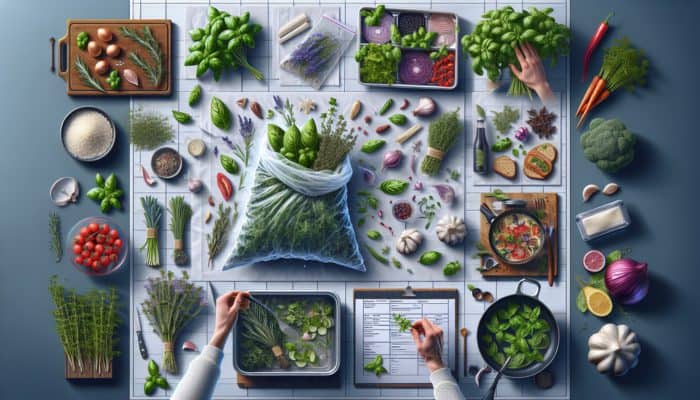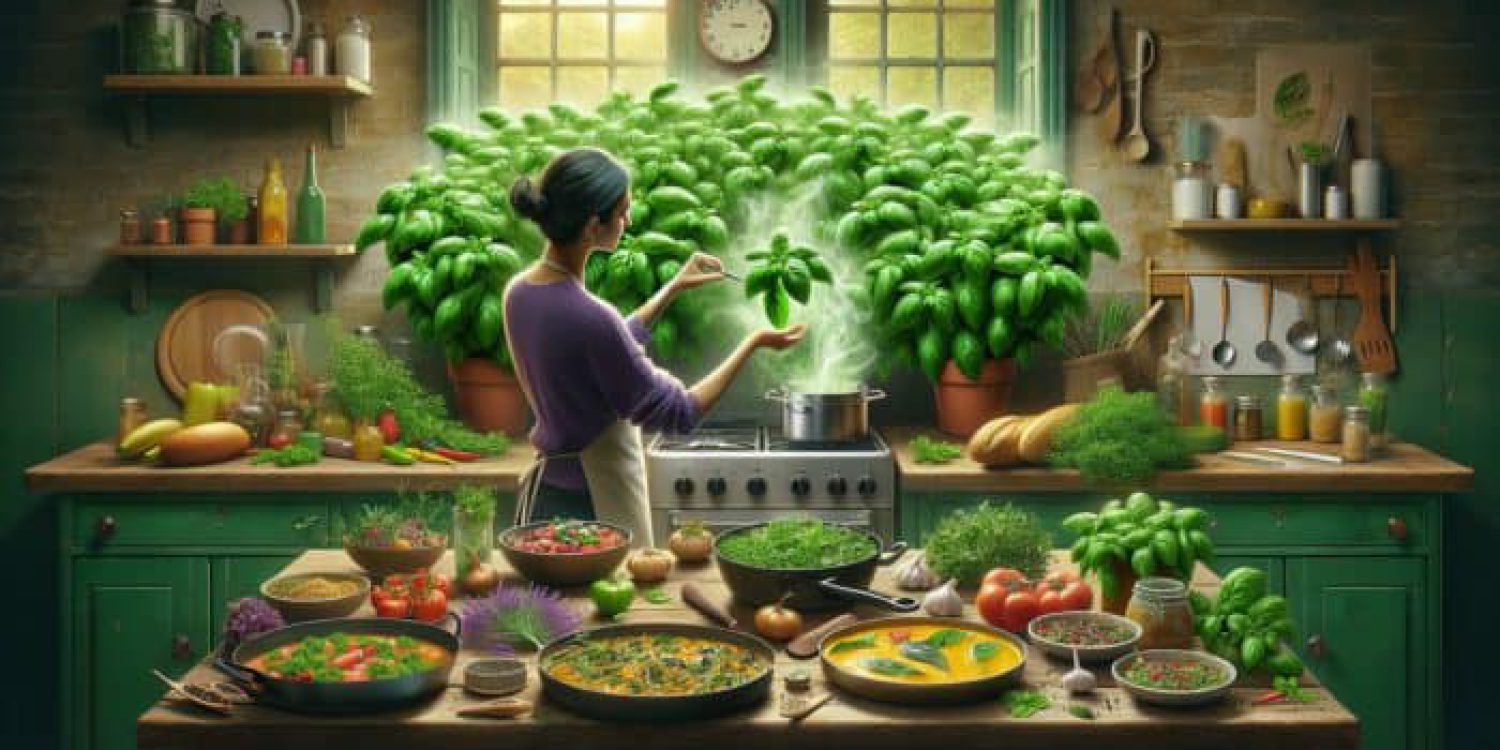Unlock the Power of Basil: A Key Herb for Vegan Cooking in the UK
How Can Basil Transform Your Vegan Dishes?

Best Herbs for Vegan Recipes: Basil is a vital herb in vegan cuisine, renowned for its invigorating and aromatic properties. Its remarkable versatility allows it to blend effortlessly into a multitude of dishes, enhancing flavours and amplifying the overall sensory experience. The vibrant green leaves of Basil are perfect for a wide range of vegan recipes, elevating the taste profile while imparting a delightful aroma that captivates the senses. In the UK, basil finds its way into summer salads, rich pestos, and robust sauces, making it an indispensable herb for both amateur cooks and professional chefs alike who wish to create culinary masterpieces.
Dishes that truly benefit from the addition of basil include:
- Classic Vegan Pesto
- Caprese Salad with Vegan Cheese
- Tomato and Basil Soup
- Vegan Pasta Dishes
- Stir-fried Veggies with Basil
- Bruschetta with Fresh Basil
- Marinades for Grilled Vegetables
- Herbed Vegan Spreads
Integrating basil into meals not only enriches flavour but also introduces numerous health benefits, such as anti-inflammatory effects and being a rich source of antioxidants, making it a powerhouse herb in the kitchen.
Mastering the Art of Growing Basil in UK Gardens
Cultivating basil in UK gardens can yield a gratifying experience, as this herb flourishes with minimal care. The secret to successfully growing basil lies in understanding its ideal conditions and adapting to the varying climates across the UK. In southern regions, basil can be sown directly into the ground from late spring, following the last frost. Conversely, gardeners in northern areas may find it advantageous to start seeds indoors or utilise a greenhouse to give plants a head start.
Here are practical steps for successfully growing basil across different regions of the UK:
- Prepare well-drained, nutrient-dense soil, ideally enriched with compost to provide the necessary nutrients.
- Select a sunny location, as basil requires at least six hours of sunlight daily for optimal growth.
- Water regularly, but be cautious not to overwater; basil prefers slightly moist soil rather than soggy conditions.
- Pinch off flowers as soon as they appear to encourage the growth of leaves, which are the primary culinary focus.
- Consider companion planting with tomatoes or peppers to enhance growth while naturally deterring pests.
By adhering to these guidelines, gardeners can enjoy a continuous supply of fresh basil throughout the growing season, perfect for enhancing their vegan culinary creations with this fragrant herb.
Exploring Popular Basil Varieties in UK Cuisine
The culinary landscape of the UK embraces a variety of basil types, each offering distinct flavours that can elevate vegan dishes. Genovese basil is arguably the most recognised, famed for its rich, sweet flavour that pairs exquisitely with tomatoes, making it perfect for sauces and pestos. UK chefs particularly favour this variety for its robust, aromatic qualities, which enhance any dish.
Thai basil introduces a hint of spiciness with anise-like notes, making it an ideal addition to vegan Asian dishes, such as curries and noodle stir-fries. Its distinctive flavour can elevate a simple dish into an extraordinary culinary experience, appealing to adventurous cooks.
Lemon basil, as its name implies, imparts a refreshing citrus aroma to dishes, making it ideal for salads and dressings. Its invigorating quality makes it a delightful addition to summer recipes, especially when paired with other herbs and greens. Understanding these varieties empowers home cooks to select the most suitable type of basil for their vegan culinary pursuits.
Insights from Experts on Essential Herbs for Vegan Recipes

What Insights Do UK Chefs Offer Regarding Herbs in Vegan Cooking?
UK chefs consistently highlight the significance of herbs in vegan cooking, recognising them as essential elements that can elevate dishes to unprecedented levels. Renowned vegan chef Gaz Oakley, known for his innovative plant-based recipes, frequently incorporates fresh herbs to enhance flavour without relying heavily on salt or fat. He asserts that herbs provide a complexity of taste that transforms basic ingredients into unforgettable meals.
Another authority in the field, Chloe Coscarelli, emphasises how herbs can be leveraged to create vibrant, exciting dishes that complement the seasonal produce available in the UK. She showcases recipes like her vegan herbed chickpea salad, featuring a medley of parsley, dill, and mint, illustrating how herbs can beautifully complement the textures and flavours of legumes.
These insights affirm that herbs are not merely an afterthought but are fundamental to the depth and character of vegan cuisine. Chefs encourage experimentation with various herbs to discover personalised flavour combinations that resonate with individual preferences and dietary goals.
How Can Herbs Dramatically Enhance Vegan Dishes?
Herbs possess the remarkable ability to elevate vegan dishes significantly. They infuse layers of flavour that can transform a straightforward meal into a gourmet experience. Culinary experts in the UK advocate that the right combination of herbs can enhance the aroma, colour, and overall appeal of a dish. This aspect is particularly pivotal in vegan cooking, where the absence of animal products necessitates additional effort to achieve depth and richness.
Beyond enhancing taste, herbs also contribute to the nutritional profile of dishes. For instance, fresh herbs like parsley and coriander are rich in vitamins and antioxidants, making them invaluable additions to any meal. The use of herbs can also inspire mindfulness in cooking, encouraging chefs and home cooks to engage with seasonal ingredients and local produce, fostering a deeper connection to the food they prepare.
Incorporating herbs provides an opportunity for creativity in the kitchen. The ability to mix and match different herbs means that a single recipe can be adapted and personalised. For example, a simple soup can be transformed with the addition of rosemary, or a salad can be brightened with the addition of mint. This flexibility positions herbs as an indispensable asset in the vegan culinary toolkit.
What Are the Best Practices for Maximising Fresh Herbs in Vegan Cooking?

To ensure the maximum impact of fresh herbs in vegan meals, several best practices should be adhered to. Firstly, utilising herbs at their peak freshness is crucial, as their flavour compounds are most potent immediately after harvest. One effective technique is storing herbs properly; wrapping them in a damp paper towel and placing them in a sealed bag can help maintain their freshness for extended periods.
When adding herbs to dishes, timing is crucial. For delicate herbs like basil and parsley, it’s advisable to incorporate them towards the end of cooking to retain their vibrant flavour and colour. In contrast, sturdier herbs such as rosemary or thyme can endure longer cooking times and are best added earlier to infuse their flavours into meals.
Chopping herbs can also release essential oils, amplifying their flavour. However, it is wise to handle them gently; bruising or over-chopping can lead to a loss of flavour. For long-term use, consider drying or freezing herbs to preserve their flavour and ensure year-round availability. By employing these techniques, home cooks can ensure their dishes are bursting with the full potential of fresh herbs.
Which Herbs Are Most Frequently Used in Vegan Recipes?
The realm of vegan cooking in the UK is rich with a diverse array of herbs. According to insights from chefs and food bloggers, several herbs consistently emerge as favourites in vegan recipes. Coriander stands out for its bright, fresh flavour, making it a staple in salads, salsas, and soups.
Basil and parsley are equally celebrated, frequently appearing in sauces, dressings, and as garnishes. Mint is cherished for its refreshing qualities, particularly in desserts and beverages, while dill has carved out a niche in salads and creamy dressings.
The rise of plant-based eating has also sparked interest in less common herbs such as tarragon and chervil, which add unique flavours to vegan dishes and are gaining traction among adventurous cooks. This trend mirrors a broader movement towards embracing local and seasonal ingredients, enabling a more dynamic and flavourful approach to vegan cooking.
How Do Herbs Enhance the Nutritional Profile of Vegan Diets?
Herbs serve not only as flavour enhancers but also pack a plethora of nutritional benefits that align seamlessly with a vegan diet. Many herbs are rich in essential vitamins and minerals, contributing to overall well-being. For example, parsley is an exceptional source of vitamins A, C, and K, which are essential for maintaining skin health, supporting immune function, and promoting bone strength.
Herbs like basil and coriander contain antioxidants that combat oxidative stress, promoting better health and potentially reducing the risk of chronic diseases. Furthermore, the presence of phytochemicals in herbs may support digestive health and enhance nutrient absorption, which is particularly beneficial for individuals adhering to a plant-based diet.
Incorporating a diverse array of herbs into daily meals can help ensure a broader intake of nutrients while adding flavour without extra calories. This makes herbs an indispensable element of vegan cooking, allowing individuals to enjoy delicious meals that support their health objectives.
Rosemary: A Robust Herb for Enhancing UK Vegan Dishes
How Does Rosemary Elevate Vegan Recipes?
Rosemary is a robust herb renowned for its strong, pine-like flavour, making it an ideal addition to an extensive array of vegan dishes. Its distinctive taste complements hearty meals, enriching the natural flavours of roasted vegetables and grain-based dishes. The aromatic qualities of rosemary can transform everyday recipes, adding depth and sophistication to even the simplest of ingredients.
Many vegan dishes that benefit from the inclusion of rosemary include:
- Rosemary Roasted Potatoes
- Vegan Shepherd’s Pie
- Herbed Focaccia Bread
- Grilled Vegetable Skewers with Rosemary
- Vegan Risotto with Rosemary and Seasonal Greens
- Stuffed Peppers with Rosemary Quinoa
- Rosemary and Garlic Bread
- Vegan Bean Stews with Rosemary
Utilising rosemary in vegan cooking not only enhances flavour but can also provide health benefits, such as improved digestion and cognitive function. Its versatility and robustness make it a favourite among UK chefs and home cooks alike who seek to create delicious plant-based meals.
How to Successfully Grow Rosemary in the UK
Growing rosemary in UK gardens can be a straightforward yet rewarding endeavour, as this woody herb thrives in a variety of conditions. However, it does prefer well-drained soil and a sunny location to flourish. If you are situated in a cooler region, consider planting rosemary in pots, allowing for easy relocation indoors during harsher winters.
To cultivate rosemary successfully, follow this step-by-step guide:
- Choose a location that receives at least six to eight hours of sunlight daily to promote healthy growth.
- Prepare well-aerated soil, ideally enriched with organic matter to provide necessary nutrients.
- Space plants adequately to promote air circulation, which helps prevent diseases from developing.
- Water regularly during the growing season, but allow the soil to dry out between watering to prevent root rot.
- Prune rosemary to encourage bushy growth and prevent woody stems from forming.
By adhering to these guidelines, aspiring gardeners can cultivate a thriving rosemary crop that complements their vegan meals throughout the year, adding a fresh and aromatic touch to various dishes.
Rosemary’s Role in Traditional UK Vegan Recipes
Rosemary holds a cherished position in traditional UK vegan cuisine, where its bold flavour enhances a variety of classic dishes. One notable example is the vegan shepherd’s pie, where rosemary is combined with lentils and vegetables to create a hearty filling that embodies the essence of home-cooked comfort.
Another beloved dish is roasted vegetables, where rosemary pairs beautifully with root vegetables like carrots and potatoes, creating an aromatic and flavorful side that complements any meal. Its strong character also lends itself well to herbed breads, such as focaccia, where the infusion of rosemary elevates the dish with a fragrant aroma and delicious taste.
These traditional recipes showcase the adaptability of rosemary, illustrating how this herb can be seamlessly integrated into vegan versions of classic British cuisine. By using rosemary thoughtfully, cooks can preserve the essence of beloved dishes while embracing plant-based principles that delight diners.
Thyme: A Versatile and Fragrant Herb in UK Vegan Cooking
What Role Does Thyme Play in Enhancing Vegan Soups and Stews?
Thyme is a versatile and fragrant herb that significantly enhances the flavour of vegan soups and stews. Its subtle earthy flavour complements various ingredients, making it an essential herb in the kitchen. Thyme’s ability to infuse warmth and depth into dishes is particularly appreciated during the colder months, as it transforms simple broths into comforting, hearty meals.
The following soups and stews notably benefit from the addition of thyme:
- Classic Vegan Vegetable Soup
- Lentil and Thyme Stew
- Mushroom and Thyme Risotto
- Chickpea and Spinach Stew
- Tomato and Thyme Soup
- Root Vegetable and Thyme Bake
- Curried Butternut Squash Soup with Thyme
- White Bean and Thyme Soup
Thyme not only enhances the flavour of these dishes but also contributes to their nutritional value, as it is rich in vitamins and beneficial compounds that support overall health. Its presence can elevate the culinary experience, making meals more satisfying and enjoyable for all.
How to Effectively Grow Thyme in UK Climates
Successfully growing thyme in the UK is achievable with a bit of knowledge about its growing conditions. Thyme thrives in well-drained soil and prefers full sun, making it an ideal herb for both gardens and pots alike. For regions with cooler climates, thyme can thrive in sheltered areas that receive ample sunlight, ensuring robust growth.
To grow thyme effectively, consider the following guidance:
- Select sandy or loamy soil to promote drainage; thyme does not tolerate soggy conditions and requires well-drained soil.
- Space plants approximately 20-30 cm apart to allow for adequate air circulation and growth.
- Water thyme sparingly, allowing the soil to dry out between waterings to prevent root rot.
- Prune regularly to encourage bushier growth and prevent flowering unless seeds are desired.
- Harvest leaves as needed to encourage new growth; thyme is a perennial herb that will return year after year with proper care.
By following these tips, gardeners can cultivate thriving thyme plants that serve as a flavourful addition to their vegan recipes, enhancing the overall dining experience.
What Are the Best Thyme Varieties for Vegan Dishes?
Thyme comes in several varieties, each possessing unique flavours that can enhance vegan dishes in different ways. Common thyme, or Thymus vulgaris, is the most widely used and cherished for its robust flavour, making it a favourite in soups, stews, and marinades.
Lemon thyme offers a delightful citrus note that complements salads and dressings, providing a refreshing twist to traditional recipes. This variety is particularly popular in vegan dishes where brightness and zest are desired.
French thyme boasts a slightly sweeter flavour, making it ideal for incorporation into creamy sauces or baked dishes. Its subtlety allows it to pair well with a range of ingredients without overpowering them, making it a versatile choice.
Each thyme variety contributes its own unique qualities to vegan recipes, encouraging creativity and exploration in the kitchen. By understanding these distinctions, cooks can make informed choices about which thyme to use for specific dishes, leading to more nuanced and flavourful meals.
Mint: A Refreshing Herb for UK Vegan Recipes
How Can Mint Be Utilised in Vegan Desserts?
Mint is a refreshing herb that brings a burst of flavour to vegan desserts, elevating them to new heights. Its cooling properties and aromatic essence make it a popular choice for various sweet treats. From ice creams to cakes, mint adds an invigorating twist that can transform standard recipes into delightful creations that tantalise the palate.
Vegan desserts where mint makes a significant impact include:
- Mint Chocolate Chip Ice Cream
- Vegan Mint Brownies
- Chocolate Mint Mousse
- Mint-infused Fruit Salad
- Vegan Mint Cupcakes
- Mint Chia Seed Pudding
- Minty Vegan Cheesecake
- Mint Mojito Sorbet
The versatility of mint in desserts lies in its ability to balance sweetness while providing a unique flavour profile. This makes it an essential herb for anyone looking to experiment with vegan baking and desserts, offering a wide range of exciting options.
Growing Mint in UK Gardens: Tips for Success
Cultivating mint in UK gardens can be both easy and rewarding, although it’s essential to manage its growth carefully, as it has the potential to become invasive. Mint thrives in rich, moist soil and can grow in partial shade to full sun, making it adaptable to a wide range of growing conditions.
Here are tips for growing mint successfully:
- Plant mint in containers to contain its spread, or use barriers if planting directly in the ground to prevent unwanted growth.
- Ensure the soil remains consistently moist but not waterlogged; mint prefers evenly damp conditions for optimal growth.
- Regularly harvest leaves to encourage bushier growth and prevent flowering, ensuring a continued supply of fresh mint.
- Consider companion planting with other herbs or vegetables that benefit from mint’s aromatic qualities, enhancing the overall garden ecosystem.
- Monitor for pests, as mint can attract aphids; use organic methods for pest control if necessary to maintain plant health.
By employing these strategies, gardeners can enjoy a bountiful supply of mint for their vegan recipes throughout the growing season, enriching their dishes with this vibrant herb.
Mint’s Role in UK Vegan Beverages
Mint’s refreshing qualities make it a sought-after ingredient in vegan beverages, offering a vibrant burst of flavour that can enhance a variety of drinks. In the UK, mint is commonly used in traditional beverages, such as tea and cocktails, but its versatility extends far beyond these applications.
Popular vegan drinks featuring mint include:
- Classic Mint Tea
- Virgin Mojito
- Minty Green Smoothies
- Mint Lemonade
- Mint-infused Iced Tea
- Mint and Cucumber Cooler
- Vegan Mint Chocolate Shake
- Minty Berry Smoothies
These refreshing beverages not only provide hydration but also boast the natural digestive benefits of mint, making them a delightful addition to any vegan lifestyle. The invigorating taste of mint can transform ordinary drinks into extraordinary experiences, pleasing the palate and refreshing the spirit.
Research-Backed Benefits of the Best Herbs for Vegan Recipes
What Nutritional Benefits Do Herbs Provide in Vegan Diets?
Incorporating herbs into vegan diets presents a wealth of nutritional benefits, enriching meals with vitamins, minerals, and antioxidants. Herbs such as parsley, thyme, and basil are particularly known for their high nutrient density, providing essential compounds that contribute to overall health and well-being.
For instance, parsley is rich in vitamins A, C, and K, which support healthy skin, immune function, and bone health. Additionally, many herbs are rich in antioxidants, which help combat oxidative stress and inflammation —essential for maintaining wellness in a plant-based diet.
Moreover, certain herbs possess antimicrobial properties that can aid in digestion and promote gut health—an important consideration for individuals following a vegan lifestyle. The nutritional advantages of herbs are vast, providing an easy way to enhance the health benefits of any meal while adding flavour without excess calories.
How Do Herbs Contribute to Flavour Profiles in Vegan Dishes?
Herbs are pivotal in constructing flavour profiles in vegan dishes, offering layers of complexity that transform mundane ingredients into extraordinary meals. Various herbs contribute unique tastes, aromas, and textures that can elevate a dish’s appeal.
For instance, the inclusion of thyme in a vegetable stew can lend an earthy warmth, while basil adds a fresh, sweet note that significantly brightens a dish. The strategic use of herbs allows chefs to create balance, enhancing both the flavour and presentation of vegan meals.
Through thoughtful incorporation of herbs, cooks can achieve a more robust and satisfying flavour profile, often mimicking the depth traditionally found in meat-based dishes. This ability to craft nuanced flavours is crucial in vegan cooking, where herbs become indispensable allies in achieving culinary excellence.
What Are the Sustainability Benefits of Using Herbs in Vegan Cooking?
The sustainability benefits of using herbs in vegan cooking are multifaceted and significant. Herbs typically require fewer resources than many traditional crops, making them an environmentally friendly option. By growing herbs at home, individuals can reduce their carbon footprint, eliminate the need for packaging, and enjoy fresh produce at its peak flavour, all while contributing to a more sustainable food system.
Moreover, using herbs in cooking promotes a farm-to-table approach, encouraging the use of local and seasonal ingredients. This not only supports local farmers but also fosters biodiversity by encouraging the growth of a diverse range of plants, rather than monocultures.
Incorporating herbs into vegan recipes can also reduce food waste; small amounts of fresh herbs can transform leftovers into exciting new meals. By embracing the culinary potential of herbs, individuals can contribute to a more sustainable food system while enjoying the flavour and health benefits that these wonderful plants provide.
Coriander: A Fresh and Vibrant Addition to UK Vegan Meals
How to Use Coriander in UK Vegan Salads
Coriander is a vibrant herb that adds a fresh, citrusy note to vegan salads, enhancing their flavour profiles and making them a delightful addition to any meal. Its distinctive taste can brighten up even the simplest salads, bringing a burst of freshness that is particularly appealing during warmer months.
Salads that benefit from coriander include:
- Chickpea Salad with Coriander and Lemon Dressing
- Mango and Avocado Salad with Coriander
- Vegan Tabbouleh with Fresh Coriander
- Quinoa Salad with Roasted Vegetables and Coriander
- Spicy Black Bean Salad with Coriander and Lime
- Asian Slaw with Coriander and Sesame Dressing
- Fresh Tomato Salad with Coriander
- Coriander and Spinach Salad with Tahini Dressing
These salads not only deliver vibrant flavours but also provide an array of nutrients, making them an excellent choice for health-conscious diners seeking refreshing and nutritious options.
How to Grow Coriander in UK Conditions
Growing coriander in the UK can be a rewarding experience, provided it is cultivated under specific growing conditions. Coriander prefers well-drained soil and a sunny location; however, it can also tolerate partial shade, making it adaptable to a range of garden settings.
To cultivate coriander successfully, consider the following tips:
- Sow seeds directly into the garden or in pots, ideally in spring or autumn for optimal growth and flavour.
- Keep the soil moist but not waterlogged; coriander prefers evenly damp conditions for healthy development.
- Thin seedlings to allow adequate space for growth, as overcrowded plants can lead to poor development and reduced yield.
- Harvest leaves regularly to encourage new growth; coriander can bolt quickly in warm conditions, so consistent harvesting is key.
- Consider growing multiple batches throughout the season to ensure a continuous supply of fresh leaves, allowing for culinary creativity throughout the year.
With careful attention, gardeners can enjoy a bountiful supply of coriander that enhances their vegan recipes throughout the year, providing a fresh and aromatic touch to various dishes.
What Are the Best Coriander Varieties for Vegan Cooking?
Various coriander varieties cater to different culinary preferences, allowing cooks to select the best type for their vegan recipes. The most popular variety is Santo, known for its slow-bolting characteristics, which make it well-suited for cooler climates and extend the growing period for fresh leaves.
Another excellent option is Leisure, which offers a robust flavour and is prized for its culinary versatility. It can be used in salads, salsas, and marinades, providing a delightful freshness to dishes that elevates their overall appeal.
Calypso coriander is also gaining popularity for its unique flavour profile, which some describe as slightly citrusy, making it perfect for pairing with vibrant Asian and Mexican dishes. Understanding these varieties can help home cooks choose the right coriander to enhance their vegan culinary creations, ensuring delicious results.
Incorporating Coriander in UK Vegan Soups and Stews
Coriander is an exceptional herb for enhancing the flavour of vegan soups and stews, bringing a fresh and aromatic touch to hearty dishes. Its ability to complement other ingredients makes coriander an invaluable addition to a variety of recipes, particularly those that benefit from bold flavours.
Soups and stews that notably benefit from coriander include:
- Vegan Lentil Soup with Coriander
- Spicy Tomato and Coriander Soup
- Curried Vegetable Stew with Coriander
- Chickpea and Coriander Coconut Curry
- Vegetable Pho with Fresh Coriander
- Moroccan Vegetable Stew with Coriander
- Split Pea and Coriander Soup
- Sweet Potato and Coriander Chowder
Incorporating coriander not only enhances the taste of these dishes but also contributes to their nutritional content, making meals more exciting and wholesome for those seeking plant-based delights.
Dill: A Delicate Herb for Elevating UK Vegan Cuisine
How Can Dill Enhance Vegan Soups and Salads?
Dill is a delicate herb that adds a unique flavour to vegan soups and salads, providing a fresh, slightly tangy note that can remarkably elevate dishes. Its aromatic qualities make it a wonderful complement to a variety of ingredients, especially those found in light summer dishes where a refreshing touch is desired.
Vegan soups and salads that benefit from dill include:
- Vegan Creamy Potato Soup with Dill
- Dill-Infused Cucumber Salad
- Chickpea Salad with Dill and Lemon
- Vegan Dill Pickle Soup
- Coleslaw with Dill and Apple Cider Dressing
- Potato Salad with Dill and Mustard Dressing
- Vegan Beetroot Salad with Dill
- Harvest Grain Salad with Dill and Fresh Veggies
These dishes highlight dill’s ability to brighten flavours and offer a refreshing touch, making it a favourite in vegan cooking, particularly during the warmer months when fresh ingredients shine.
How to Grow Dill Successfully in the UK
Growing dill in UK gardens can be a straightforward process, provided that its growing needs are met. Dill prefers well-drained soil and a sunny location, thriving in areas that receive full sun for optimal growth and flavour development.
To cultivate dill successfully, consider the following tips:
- Sow dill seeds directly into the soil from spring through early summer for the best results and flavour.
- Ensure the soil is moist but not waterlogged; dill prefers consistently damp conditions for optimal growth and development.
- Thin seedlings to allow adequate space for growth; overcrowding can hinder development and lead to weaker plants.
- Harvest leaves regularly to encourage further growth; dill is best used fresh for maximum flavour and aroma.
- Be mindful of dill’s short life cycle, as it can bolt quickly when temperatures rise, so timely harvesting is essential.
By following these guidelines, gardeners can enjoy a continuous supply of fresh dill, enhancing their vegan dishes throughout the growing season and adding a delightful herbal note to meals.
Incorporating Dill in UK Vegan Sauces and Dressings
Dill is a versatile herb that can enhance a variety of vegan sauces and dressings, providing a unique flavour that elevates dishes dramatically. Its delicate taste pairs beautifully with creamy, tangy, or fresh elements, making it a popular choice in numerous culinary applications.
Vegan sauces and dressings featuring dill include:
- Vegan Tartar Sauce with Dill
- Dill and Cashew Cheese Spread
- Creamy Dill Dressing for Salads
- Vegan Ranch Dressing with Dill
- Herbed Dill Sauce for Grilled Vegetables
- Dill-infused Vinaigrette for Grain Bowls
- Homemade Dill Pickle Relish
- Dill and Lemon Sauce for Pasta
These recipes showcase dill’s versatility and its ability to enhance the overall flavour profile of vegan dishes, adding a fresh and aromatic touch that delights the palate and complements many meals.
Using Dill as a Garnish in UK Vegan Dishes
Dill serves as an excellent garnish in vegan dishes, adding both flavour and visual appeal. Its feathery leaves create a beautiful contrast against a variety of colours, making it a popular choice for presentations that aim to impress.
Dishes that benefit from dill as a garnish include:
- Vegan Creamy Soup topped with Fresh Dill
- Stuffed Bell Peppers with Dill Garnish
- Vegan Quinoa Bowls adorned with Dill Sprigs
- Salads with Dill for an Elegant Touch
- Dill-Infused Pasta Dishes topped with a Sprinkling of Fresh Dill
- Vegan Roasted Vegetables with Dill as a Finishing Touch
- Homemade Dips Garnished with Fresh Dill
- Vegan Potato Salad with Dill for a Beautiful Presentation
Utilising dill as a garnish not only enhances the aesthetic appeal of dishes but also amplifies the flavour, providing an aromatic experience that complements the meal beautifully, making it a must-have in the kitchen.
Storing and Preserving Dill in the UK
Effectively storing and preserving dill ensures that this delicate herb maintains its freshness for longer periods. Given its short shelf life, particularly in warmer months, proper handling is essential to enjoy its full flavour potential.
Here are some effective methods for storing and preserving dill:
- Wrap fresh dill in a damp paper towel and place it in a plastic bag; this method keeps it fresh for a week or more, retaining its flavour and aroma.
- For longer preservation, consider freezing dill; chop the leaves and store them in ice cube trays filled with water for easy use later.
- Dry dill by hanging bundles upside down in a cool, dry place. Once dried, store it in airtight containers away from sunlight to maintain its quality.
- Utilise dill in pickling recipes to harness its flavour, as it pairs beautifully with cucumbers and other vegetables.
- Incorporate preserved dill into sauces and dressings for added depth of flavour, enhancing various dishes.
By employing these storage techniques, home cooks can ensure a steady supply of fragrant dill to enhance their vegan meals, even during the off-season when fresh herbs may not be available.
Parsley: A Versatile Herb Enhancing UK Vegan Recipes
How Does Parsley Elevate Flavour in Vegan Dishes?
Parsley is a versatile herb that adds a mild, fresh taste to a wide variety of vegan dishes. Its vibrant green leaves not only enhance the flavour of meals but also contribute to the visual appeal, making dishes more enticing. Parsley can be used fresh or dried, rendering it an adaptable ingredient for recipes ranging from salads to garnishes.
Examples of vegan dishes that incorporate parsley include:
- Vegan Tabouli Salad
- Chickpea and Parsley Quinoa Salad
- Lentil Soup with Parsley
- Vegan Meatballs with Parsley
- Garlic and Parsley Roasted Potatoes
- Herbed Vegan Pasta Dishes
- Parsley and Lemon Rice
- Stuffed Peppers with Parsley and Vegan Cheese
The ability of parsley to brighten flavours makes it a staple herb in many kitchens, enhancing both taste and nutrition in vegan recipes, ensuring meals are as wholesome as they are delicious.
How to Successfully Grow Parsley in UK Gardens
Growing parsley in UK gardens can be a gratifying experience, as this herb thrives in a variety of conditions. It prefers nutrient-rich, well-drained soil, making it an excellent choice for both sunny and partially shaded locations, which allows for flexibility in garden design.
To cultivate parsley successfully, follow these guidelines:
- Sow seeds directly in the garden or start them indoors for a head start; germination typically takes a few weeks, so patience is essential.
- Keep the soil consistently moist, as parsley prefers even moisture but should not be waterlogged to ensure healthy growth.
- Thin seedlings to allow ample space for growth; overcrowded plants may produce fewer leaves and hinder development.
- Regularly harvest leaves to encourage new growth and prevent bolting, ensuring a continuous supply throughout the growing season.
- Consider companion planting with other herbs to enhance growth and naturally deter pests, promoting a healthier garden ecosystem.
By following these steps, gardeners can enjoy a continual supply of fresh parsley that enhances their vegan recipes throughout the growing season, providing a fresh and nutritious boost to meals.
Popular Parsley Varieties in UK Vegan Cooking
Two primary varieties of parsley are commonly used in vegan cooking: Curly parsley and Flat-leaf parsley (also known as Italian parsley). Each variety offers its unique flavour and culinary applications, providing versatility in the kitchen.
Curly parsley is often used as a garnish due to its decorative appearance, adding a pop of colour to dishes. However, it also provides a milder flavour that can complement a range of recipes without overpowering other ingredients.
Flat-leaf parsley is preferred by many chefs for its stronger flavour and versatility, making it ideal for incorporating into sauces, salads, and soups, as it holds up well during cooking and retains its vibrant taste throughout the meal.
Understanding the differences between these varieties allows cooks to choose the best parsley for their vegan dishes, enhancing both flavour and presentation while ensuring delightful meals for all.
What Are the Nutritional Benefits of Parsley in Vegan Diets?
Parsley is a powerhouse of nutrition, making it an invaluable addition to a vegan diet. Rich in vitamins A, C, and K, parsley supports various bodily functions, including immune health, skin health, and bone strength, contributing to overall well-being.
Additionally, parsley is abundant in antioxidants, which can help combat oxidative stress and reduce inflammation. These properties are particularly beneficial for those following a plant-based diet, as they promote overall health and well-being, significantly enhancing the nutritional profile of meals.
Incorporating parsley into meals not only enhances flavour but also boosts the nutritional content of vegan dishes, supporting a balanced and healthful diet. By embracing parsley and its myriad of benefits, home cooks can create delicious meals that nourish both body and soul.
FAQs About Herbs in Vegan Cooking
What are the best herbs for vegan cooking?
The best herbs for vegan cooking include basil, parsley, coriander, mint, thyme, and dill. Each herb brings unique flavours and nutritional benefits, enhancing a variety of dishes and making meals more delicious and wholesome.
Can I grow herbs indoors in the UK?
Yes, many herbs can be grown indoors in the UK. Choose a sunny windowsill and utilise pots with good drainage to cultivate herbs like basil, parsley, and mint year-round, allowing for fresh flavours in your kitchen.
How do I store fresh herbs to maintain their optimal freshness?
Fresh herbs can be stored by wrapping them in a damp paper towel and placing them in a plastic bag in the fridge or by freezing them in ice cube trays with water for longer preservation, ensuring they retain their flavour and aroma.
Are fresh herbs healthier than dried herbs?
Fresh herbs often contain more essential oils and nutrients compared to dried herbs, making them a healthier choice. However, dried herbs are convenient and can still provide flavour and health benefits, making them valuable in the kitchen.
What is the difference between flat-leaf and curly parsley?
Flat-leaf parsley has a stronger flavour and is preferred for cooking. In contrast, curly parsley is often used as a garnish due to its decorative appearance and milder taste, adding visual appeal to dishes.
Can I substitute fresh herbs for dried herbs in recipes?
Yes, you can substitute fresh herbs for dried herbs, but the general rule is to use three times the amount of fresh herbs due to their lower potency in flavour compared to dried herbs.
How can I use herbs to enhance the flavour of vegan dishes?
Using herbs like basil, rosemary, and thyme can add depth and complexity to vegan dishes. Experimenting with different combinations of herbs can create exciting flavour profiles that enhance the overall dining experience.
What are the best practices for harvesting herbs?
To harvest herbs, cut leaves above the node, leaving enough foliage for continued growth. Regular harvesting encourages bushier plants and prevents flowering, ensuring a continual supply of fresh herbs for culinary use.
How do herbs contribute to a sustainable diet?
Herbs require less water and fewer resources to grow compared to many crops, making them a sustainable choice. Growing herbs at home also reduces the carbon footprint associated with food transport, promoting a more environmentally friendly lifestyle.
What are some popular vegan dishes that use herbs?
Popular vegan dishes featuring herbs include vegan pesto, chickpea salad with parsley, lentil soup with thyme, and mint chocolate chip ice cream, all of which showcase the versatility and culinary potential of herbs in cooking.

























1 Comment
Your insights on basil as a cornerstone of vegan cooking are spot on! I’ve always found that basil not only brings such a vibrant taste but also contributes to a sense of warmth in the dishes. It reminds me of summer evenings spent with friends, where we’d whip up fresh basil pesto and pair it with homemade vegan pasta. There’s something so comforting and nostalgic about that experience, and the herb truly plays a starring role.